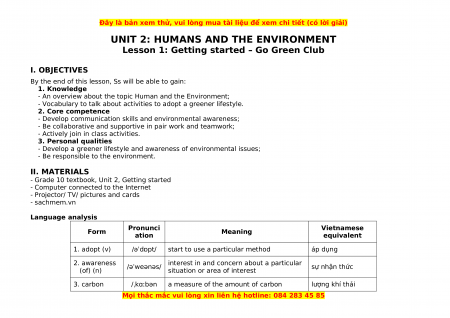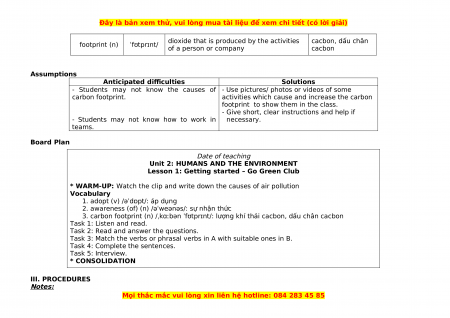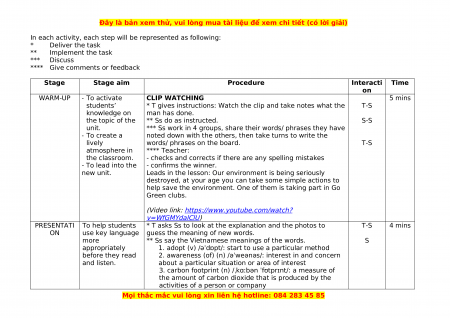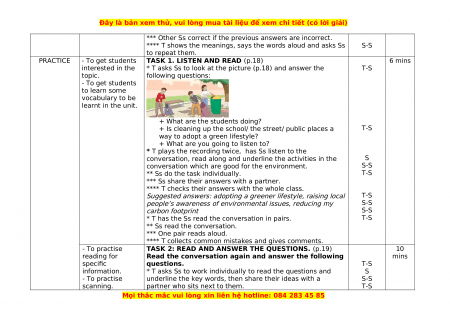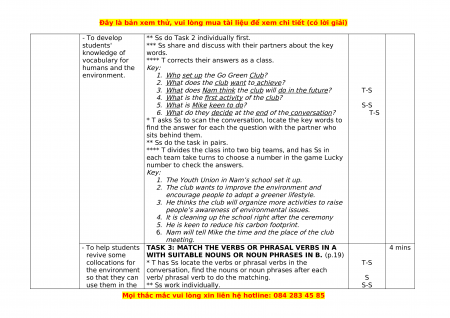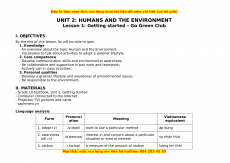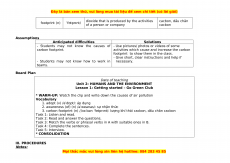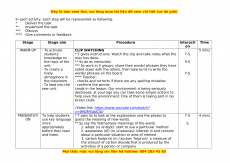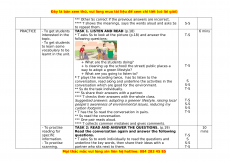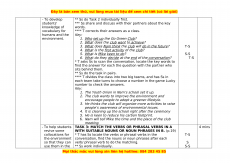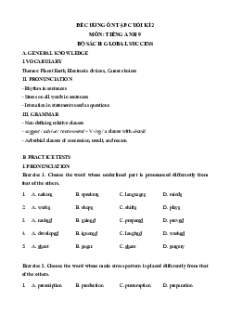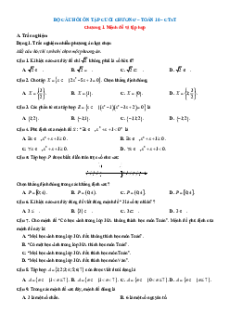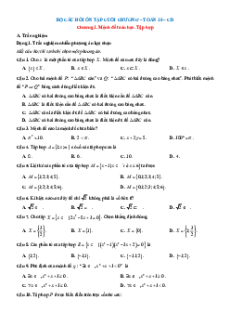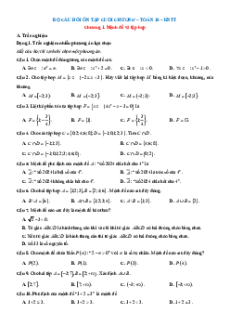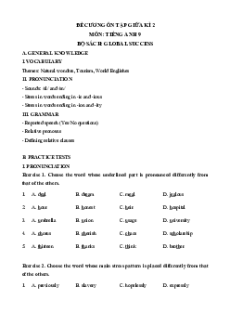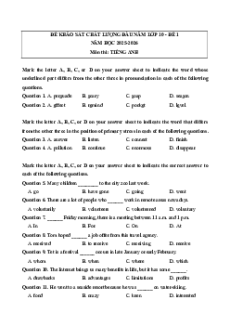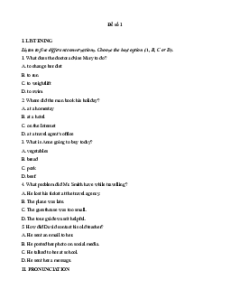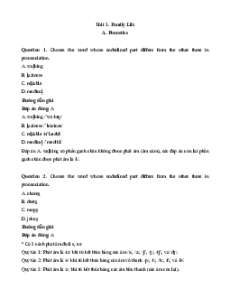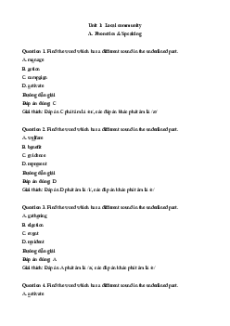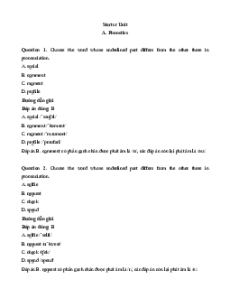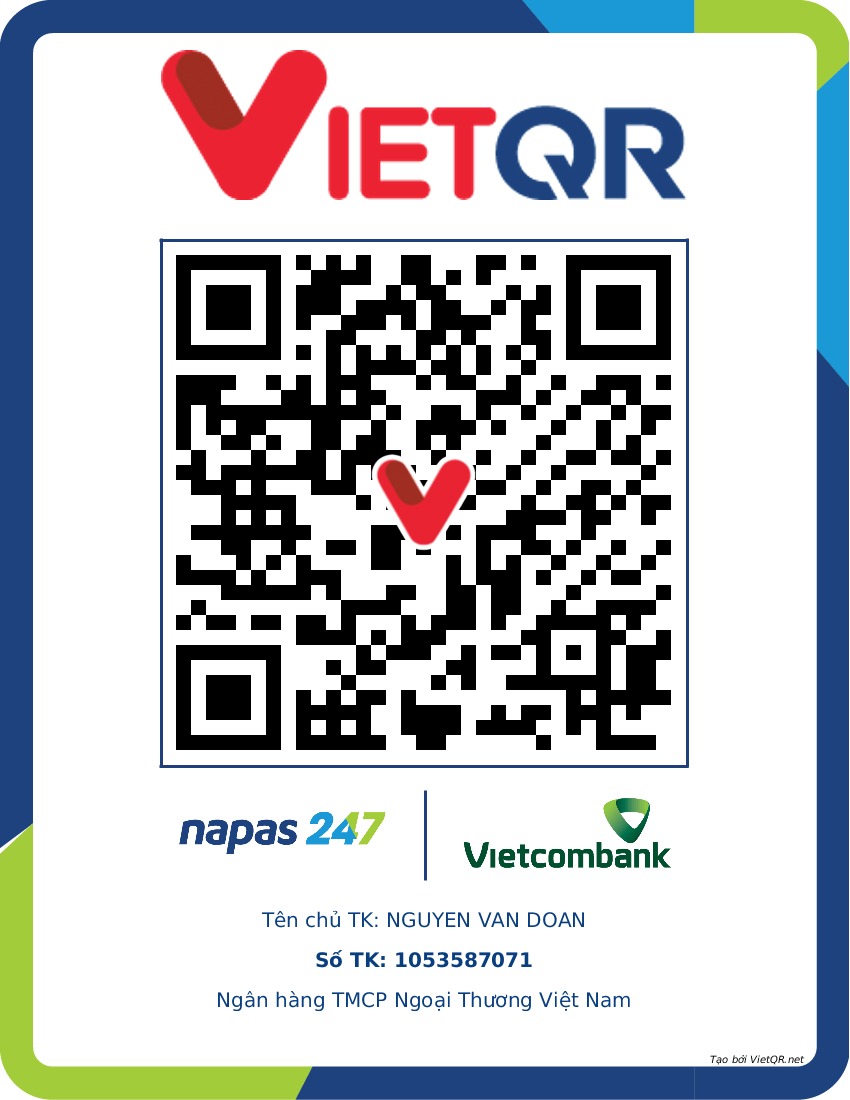UNIT 2: HUMANS AND THE ENVIRONMENT
Lesson 1: Getting started – Go Green Club I. OBJECTIVES
By the end of this lesson, Ss will be able to gain: 1. Knowledge
- An overview about the topic Human and the Environment;
- Vocabulary to talk about activities to adopt a greener lifestyle. 2. Core competence
- Develop communication skills and environmental awareness;
- Be collaborative and supportive in pair work and teamwork;
- Actively join in class activities. 3. Personal qualities
- Develop a greener lifestyle and awareness of environmental issues;
- Be responsible to the environment. II. MATERIALS
- Grade 10 textbook, Unit 2, Getting started
- Computer connected to the Internet
- Projector/ TV/ pictures and cards - sachmem.vn Language analysis Pronunci Vietnamese Form Meaning ation equivalent 1. adopt (v) /əˈdɒpt/
start to use a particular method áp dụng 2. awareness
interest in and concern about a particular /əˈweənəs/ sự nhận thức (of) (n) situation or area of interest 3. carbon /ˌkɑːbən
a measure of the amount of carbon lượng khí thải
dioxide that is produced by the activities cacbon, dấu chân footprint (n) ˈfʊtprɪnt/ of a person or company cacbon Assumptions
Anticipated difficulties Solutions
- Students may not know the causes of - Use pictures/ photos or videos of some carbon footprint.
activities which cause and increase the carbon
footprint to show them in the class.
- Give short, clear instructions and help if
- Students may not know how to work in necessary. teams. Board Plan Date of teaching
Unit 2: HUMANS AND THE ENVIRONMENT
Lesson 1: Getting started – Go Green Club
* WARM-UP: Watch the clip and write down the causes of air pollution Vocabulary
1. adopt (v) /əˈdɒpt/: áp dụng
2. awareness (of) (n) /əˈweənəs/: sự nhận thức
3. carbon footprint (n) /ˌkɑːbən ˈfʊtprɪnt/: lượng khí thải cacbon, dấu chân cacbon Task 1: Listen and read.
Task 2: Read and answer the questions.
Task 3: Match the verbs or phrasal verbs in A with suitable ones in B.
Task 4: Complete the sentences. Task 5: Interview. * CONSOLIDATION III. PROCEDURES Notes:
In each activity, each step will be represented as following: * Deliver the task ** Implement the task *** Discuss **** Give comments or feedback Stage Stage aim Procedure Interacti Time on WARM-UP - To activate CLIP WATCHING 5 mins students’
* T gives instructions: Watch the clip and take notes what the T-S knowledge on man has done. the topic of the ** Ss do as instructed. S-S unit.
*** Ss work in 4 groups, share their words/ phrases they have - To create a
noted down with the others, then take turns to write the lively words/ phrases on the board. T-S atmosphere in **** Teacher: the classroom.
- checks and corrects if there are any spelling mistakes - To lead into the - confirms the winner. new unit.
Leads in the lesson: Our environment is being seriously
destroyed, at your age you can take some simple actions to
help save the environment. One of them is taking part in Go Green clubs.
(Video link: https://www.youtube.com/watch? v=WfGMYdalClU) PRESENTATI To help students
* T asks Ss to look at the explanation and the photos to T-S 4 mins ON
use key language guess the meaning of new words. more
** Ss say the Vietnamese meanings of the words. S appropriately
1. adopt (v) /əˈdɒpt/: start to use a particular method before they read
2. awareness (of) (n) /əˈweənəs/: interest in and concern and listen.
about a particular situation or area of interest
3. carbon footprint (n) /ˌkɑːbən ˈfʊtprɪnt/: a measure of
the amount of carbon dioxide that is produced by the
activities of a person or company
*** Other Ss correct if the previous answers are incorrect.
**** T shows the meanings, says the words aloud and asks Ss S-S to repeat them. PRACTICE - To get students
TASK 1. LISTEN AND READ (p.18) 6 mins interested in the
* T asks Ss to look at the picture (p.18) and answer the T-S topic. following questions: - To get students to learn some vocabulary to be learnt in the unit. + What are the students doing?
+ Is cleaning up the school/ the street/ public places a T-S
way to adopt a green lifestyle?
+ What are you going to listen to?
* T plays the recording twice, has Ss listen to the
conversation, read along and underline the activities in the S
conversation which are good for the environment. S-S
** Ss do the task individually. T-S
*** Ss share their answers with a partner.
**** T checks their answers with the whole class.
Suggested answers: adopting a greener lifestyle, raising local T-S
people’s awareness of environmental issues, reducing my S-S carbon footprint S-S
* T has the Ss read the conversation in pairs. T-S ** Ss read the conversation. *** One pair reads aloud.
**** T collects common mistakes and gives comments. - To practise
TASK 2: READ AND ANSWER THE QUESTIONS. (p.19) 10 reading for
Read the conversation again and answer the following mins specific questions. T-S information.
* T asks Ss to work individually to read the questions and S - To practise
underline the key words, then share their ideas with a S-S scanning.
partner who sits next to them. T-S
Giáo án Unit 2: Humans and the environment Tiếng anh 10 Global success
1.2 K
591 lượt tải
MUA NGAY ĐỂ XEM TOÀN BỘ TÀI LIỆU
CÁCH MUA:
- B1: Gửi phí vào TK:
1133836868- CT TNHH DAU TU VA DV GD VIETJACK - Ngân hàng MB (QR) - B2: Nhắn tin tới Zalo VietJack Official ( nhấn vào đây ) để xác nhận thanh toán và tải tài liệu - giáo án
Liên hệ ngay Hotline hỗ trợ: 084 283 45 85
Bộ giáo án Tiếng anh 10 Global success được cập nhật liên tục trong gói này từ nay đến hết tháng 6/2023.
Để tải tài liệu gốc về máy bạn click vào nút Tải Xuống ở trên!
Thuộc bộ (mua theo bộ để tiết kiệm hơn):
- Bộ giáo án Tiếng anh 10 Global success năm 2023 mới, chuẩn nhất được thiết kế theo phong cách hiện đại, đẹp mắt, trình bày chi tiết cho từng bài học và bám sát chương trình Sách giáo khoa Tiếng anh 10.
- Mua trọn bộ sẽ tiết kiệm hơn tải lẻ 50%.
Đánh giá
4.6 / 5(1182 )5
4
3
2
1
Trọng Bình
Tài liệu hay
Giúp ích cho tôi rất nhiều
Duy Trần
Tài liệu chuẩn
Rất thích tài liệu bên VJ soạn (bám sát chương trình dạy)
TÀI LIỆU BỘ BÁN CHẠY MÔN Tiếng Anh
Xem thêmTÀI LIỆU BỘ BÁN CHẠY Lớp 10
Xem thêmTài liệu bộ mới nhất

!"#$%& '(!)(!*#&++!,"-.!'+!#
/0012%3045631347
"8.9:+7#",+)
28;1<5
!"
$87141=
#!
!!
$"
>8?401@0
#
"
""8'(#+-"(/)
%&'(!)*%
+,
-$./ .
"
/00
A14
?41
1
'
,0
@
&"01 .234. 56
*"
0101
.2322.
789
:" .;!<=2 > ?@!AB
'BCCD1%EFG$F>GHFH

01 3CD.
(>
EF
(00=10
(=55I0 )110
!
"
! !
"
).
"
%
"
9145?
#
$%& '(!)(!*#&++!,"-.!'+!#
/0012%3045631347
JK(-'L ?%G
,14
&"01.234.56
*"0101.2322.789
:"01.;!<=23CD.?@!ABEF
/!&H"
/!*IJ"
/!:K"
/!L+"
/!M,"
J7.!)./"*(#".!
"""8?-.7+* -+)
!10%
'BCCD1%EFG$F>GHFH

,
N #!
NN ,!
NNN #
NNNN %!
) ) ?4154 "4
1
#
GIK)- - /
O
!
"
- /
"
/
"
7/"?K(#7&"!3
N/G!
"
NN"
NNN!L.
!
."
NNNN/
!!
P"
HQ
!
"Q!%
%"
0 !.."".R
SG%KT+)1
/
/
M
-IU//,
QU
/
!
"
N/!!(
"
NN "
&"01.234.
*"0101.2322.
:"01.;!<=23CD.
>(
/
L
'BCCD1%EFG$F>GHFH

NNNQ"
NNNN/!
"
-I+/,+ /
"
/
"
#();28/")#+!(!*-+(*0"&V1
N/!!0"&V1
J
WGR
W,..
R
WGR
J/
"
NN!"
NNN"
NNNN/!"
O
N/"
NN"
NNNQ"
NNNN/!"
/
/
/
/
/
X
/
P
"
/
"
#();$%-+(*(!*(!)K+-#&+M +)#".!)80"&Y1
-5140150<4N11<
@0108
N/!!J
!
("
/
/
&'
'BCCD1%EFG$F>GHFH

/
Z
!
"
NN/!*P"
NNN!
"
NNNN/"
[
&" G %%+R
*" G R
:" G U!R
L" G PR
M" G K!!R
X" G R
N/!!
PJ
"
NN!"
NNNN/
!H!
!"
[
&" /T)UO"
*" /
"
:" !\
O"
L" ,
M" !"
X"
UK!
"
/
/
/
#();>%'(#7&#&+,+-9).-?&-()(/,+-9)"!(
K"#&) "#(9/+!. !).-!. !?&-()+)"!980"&Y1
N/
P
."
NN!"
/
L
'BCCD1%EFG$F>GHFH
